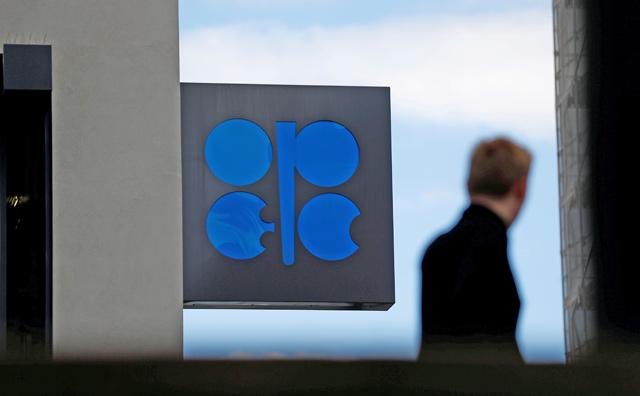You are here
OPEC confidential report sees market share squeeze to 2019
By Reuters - Nov 05,2015 - Last updated at Nov 05,2015
LONDON — Global demand for crude oil produced by the Organisation of the Petroleum Exporting Countries (OPEC) will remain under pressure in the next few years, the group said in an internal report, potentially fuelling a debate on its strategy of defending market share rather than prices.
The draft report of OPEC's long-term strategy, seen by Reuters, forecasts crude supply from OPEC, which has an output target of 30 million barrels per day (bpd), falling slightly from 2015's level until 2019, unless output slows faster than expected in rival producers.
OPEC governors, official representatives of the 12 member countries, met at the group's Vienna headquarters on Wednesday to approve the final draft of the report.
The 44-page report, marked "CONFIDENTIAL," includes an annex containing comments from two members, Iran and Algeria, suggesting OPEC return to its old policy of propping up prices at a desired level by adjusting supplies.
"Reaching agreement on a fair and reasonable price of oil for the next six to 12 months" is one of the steps that Iran recommends OPEC take. "OPEC production ceiling should be set for six or 12 months intervals."
OPEC oil ministers meet on December 4 to decide whether to extend the strategy of allowing prices to fall to slow higher-cost rival supply. Since November 2014, when the group adopted that policy, OPEC production has risen but prices have deepened their collapse, hurting oil revenue.
The report sees only a gentle recovery over the next few years in oil prices, which have more than halved to $50 a barrel since June 2014 due to plentiful supply.
OPEC's basket of crude oils is assumed in the report at $55 in 2015 and to rise by $5 a year to reach $80 by 2020.
Long-term gain in market share
Saudi Arabia, supported by other relatively wealthy Gulf members, led the change in strategy last year. Riyadh shows no sign of changing course, seeing the approach as long-term.
The draft report supports the view that OPEC's market share will rise in the long run as output of shale oil, also known as tight oil, and natural gas liquids is curbed.
"It is... assumed that tight crude and unconventional NGL supply will reach a maximum at some point after 2020 and then start to decline slightly," the report said.
"As a result of non-OPEC supply developments, OPEC crude is expected to rise over the long term, reaching 40.7 million bpd in 2040," it added. "Moreover, the share of OPEC crude in the world liquids supply in 2040 is 37 per cent, which is above current levels of around 33 per cent."
Over the long run, as non-OPEC supply growth fades, the report assumes oil will rise further and its nominal price will reach $162, or $95 in 2014 dollars.
But a chart in the report also presents a scenario in which non-OPEC supply is more resilient, putting increased downward pressure on the group's market share and highlighting the uncertainty over future demand for OPEC oil.
"OPEC crude production would reach its lowest point in this scenario at 28.7 million bpd in 2023," the report indicated. "The resulting range for OPEC crude in 2040 amounts to 9.4 million bpd, which highlights the challenges for member countries' long-term investment decisions."
OPEC publishes long-term strategy reports every five years. Its 2010 report did not mention shale oil as a serious competitor, highlighting the dramatic change the oil market has undergone in the past few years.
The long-term report, prepared by OPEC's research team in Vienna, traditionally cautions that it does not articulate the final position of OPEC or any member country on any proposed conclusions it contains.
Last month, a meeting of oil experts from OPEC and non-member countries discussed the risk that low oil prices would reduce investment in new supplies but agreed no concrete steps on boosting the market.
Venezuela's Oil Minister Eulogio del Pino presented his country's proposals for measures to bolster prices, such as an OPEC and non-OPEC summit and said the market equilibrium price for crude was around $88 a barrel.
"At $40 a barrel, we are below the equilibrium price," he told reporters. "We are concerned about the depletion of the reservoirs, the decline of the production and about the investment that is required."
Non-OPEC producers have refused to work with OPEC in cutting supply to reduce a surplus. OPEC has refused to cut supply alone and many members have raised output.
Russia's representative at the meeting, Ilya Galkin, head of the international cooperation department at the energy ministry, said there is real risk for oil-producing countries of under-investing.
Separately, just as the energy industry has brushed aside concerns that the world could run out of oil, industry executives now say they believe it is demand, rather than supply, that is nearing its apex.
In 1985, Ian Taylor, today the chief executive of the world's largest oil trader Vitol, was part of a team at Royal Dutch Shell that forecast oil prices would rise five fold to $125 a barrel in 2015, as global reserves were expected to become more scarce. Now he says it is unlikely to ever reach those levels again.
Oil today stands at around $50 a barrel, having more than halved since June 2014 after global supplies dramatically rose due in large part to the US shale oil boom but also due to the unlocking of huge offshore reserves in Brazil, Africa and Asia.
"We all talk about 'peak supply' and maybe with shale that is becoming a disabused concept. I have begun feeling that... we are coming to peak demand towards 2030," Taylor said on Wednesday at The Economist Energy Summit in London.
"I believe we may not see $100 [a barrel] ever again," Taylor added.
Such forecasts come at a time when oil companies have slashed billions off their budgets and scrapped more than $200 billion of oil and gas projects to cope with the sharp price drop.
Lower future demand for fossil fuels could wreck the finances of producing countries like Saudi Arabia, Russia and Venezuela that depend on high oil prices to fund public spending, but would be an overall boon for the world.
The overwhelming majority of people live in countries — whether rich like the United States, middle-income like China or poor like Bangladesh — that consume more energy than they produce.
The United Nations believes sharp reductions in fossil fuel use are also necessary to protect the earth from catastrophic effects of climate change.
Higher fuel efficiencies for cars and the industry's switch towards less-polluting sources of energy such as gas, biofuels, solar and wind power, mean that oil demand could plateau in the coming decades.
Fossil fuel consumption could be further clipped if governments tighten regulations in order to combat climate change at a UN conference in Paris next month.
BP earlier this week said the world is no longer at risk of running out of oil or gas for decades ahead. Existing technology is capable of unlocking so much fossil fuel that global reserves would almost double by 2050 to 4.8 trillion barrels of oil equivalent (boe), the British giant indicated.
With new exploration and technology, the resources could leap to a staggering 7.5 trillion boe, it said.
Back to the past
"Peak demand" does not mean people will consume less energy overall. On the contrary, global energy consumption is expected to soar in the coming decades as the planet's population grows and Asian and African economies develop.
But while the world's total energy consumption is set to increase by more than one third from 2012 to 2040, oil's share is set to shrink from 31 per cent to 26 per cent, according to the International Energy Agency's (IEA) 2014 World Energy Outlook.
The IEA forecasts global oil demand to rise modestly by around 0.5 per cent per year through to 2040 to 103.9 million barrels per day, driven by countries outside the Organisation for Economic Cooperation and Development.
Eldar Saetre, chief executive officer of Norwegian oil company Statoil, sees oil demand actually declining, although oil companies will still have to invest to replace existing capacity as it declines.
"In our scenario, we see much lower oil consumption than we have today," he told reporters on the sidelines of the conference. "You still need a lot of additional [oil] capacity because of natural decline... Overall, we see the same type of combined levels for oil and gas but lower oil and more gas."
The change is expected to hit Western economies first, with demand set to go back to levels last seen in 1966, according to Dev Sanyal, BP's executive vice president, strategy and regions.
"We do believe the aspect that people were set about 25 years ago, which was peak oil, has now clearly gone away. There is a lot of supply of both oil and gas. The big challenge in OECD economies is peak demand," he said.
Still, some firms are expecting robust demand in developing countries will keep the world's thirst for oil strong. The President of New Energies at France's Total, Philippe Boisseau, said he did not expect global demand to plateau, even though OECD consumption is likely to decline.
"Even when including the huge efficiency efforts, [oil demand] will grow. So I don't believe in peak demand for the world. For Europe and the West, maybe, but not for the world," he added.
Related Articles
LONDON — The Organisation of the Petroleum Exporting Countries (OPEC) on Monday predicted global demand for its crude oil will be less than
LONDON — Unseasonably warm weather and rising supply will keep the crude oil market oversupplied until at least late 2016 and could push the
ALGIERS – The Organisation of the Petroleum Exporting Countries (OPEC) and its allies reduced oil output in August as a drop in Iranian supp
















